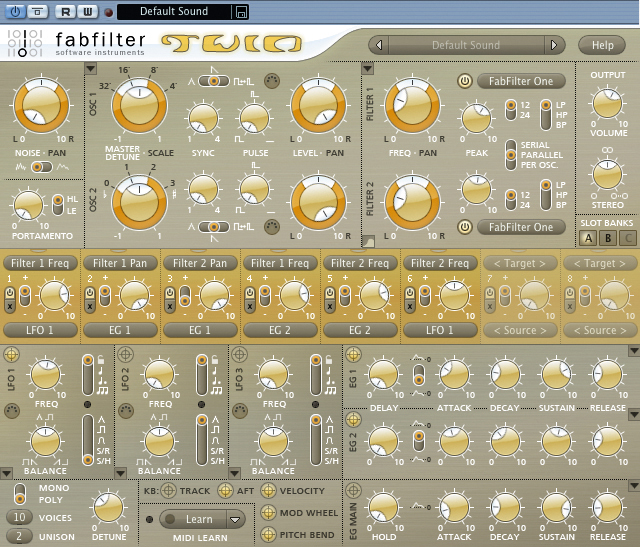MusicRadar Verdict
If you liked FabFilter One, you'll like Twin at least twice as much!
Pros
- +
Superb sounding oscillators. Filters that will blow your socks off. Every envelope parameter can be modulated. Intuitive interface, rock solid performance. The best modulation ever!
Cons
- -
Relatively expensive.
MusicRadar's got your back

CMU100.rev_twin.main_grab.jpg

CMU100.rev_twin.mod.jpg
It may not be the most versatile synth in the world, but FabFilter One sure sounds sweet. FabFilter One is particularly notable for its spot-on oscillator and silky smooth filter.
When used in combination, these features enable you to create a sound that's rich, fat and downright Herculean.
What 'One' doesn't have is an overabundance of features, and while we certainly appreciate that this makes it very easy to use, we can't pretend that we don't hanker for more. Of everything.
Luckily, this is exactly what FabFilter is giving us with Twin. It has everything that makes One so special, but adds a host of new features (not least of which is probably the best modulation routing system we've ever seen). There's more polyphony, more oscillators, and far greater possibilities.
The lowdown
FabFilter Twin is a cross-platform, 24-voice virtual analogue synth that can be used standalone or as a VST or AU plug-in.
When you first consider its spec sheet, you might feel that its $129 price tag is rather excessive, but believe us when we say that with Twin, you're paying for quality rather than quantity of features.
Twin is download-only, and when we were installing it, we were surprised not to be asked to jump through any authorisation hoops or plug in any dongles.
The manual is offered online and as a PDF file, although the chances are that you'll only need it if you're an absolute beginner.
Twin's sound is based on a pair of virtual analogue oscillators - each of these offers saw, triangle and pulse waveforms.
These oscillators can be forced into synchronisation, panned separately, and pitched with polyphonic portamento.
FabFilter have won a lot of acclaim for the quality of their filters, and Twin gives you two of them. They too can be individually panned; this is done using concentric dials that surround the Frequency knobs.
The filters are multimode and offer low, high and band-pass functions. You can choose between 12dB and the more Moog-like 24dB filter slopes, and you also have control over the resonance (or Peak).
The filters sound fantastic, and run the sonic gamut from smooth to raw. Like the best vintage filters, they can be driven into self-oscillation.
Odds 'n' mods
FabFilter has been even more generous with its modulation parameters. There are three ADSR envelope generators, two of which have a Delay setting.
The third offers a Hold knob that calls to mind Korg's MS-20. EG1 and EG2 can be inverted.
Such simple envelope generators might seem out of place on what is a modern soft synth, but simplicity has always been one of FabFilter's strong suits, and these four-stage shapers are very much in keeping with Twin's overall look and feel.
What's more, if you dig a little deeper, you'll find that every single envelope parameter can be modulated!
We've seen decay and even attack settings as modulation destinations on occasion, but it is unusual, to say the least.
For more modulation mayhem, you can turn to any one of Twin's trio of LFOs. These offer the usual triangle, sine and square shapes, but you'll also find random triangle and sample-and-hold shapes.
The LFOs can be synced to the host's tempo, and you can modulate their frequencies.
Speaking of modulation, FabFilter has set a new standard for mod routings. If you want to modulate a given destination, you simply click on the source and drag it to the parameter that you wish to control.
You can create up to 24 mod routings, and even the mod amounts themselves can be modulated. It's a clean, efficient and powerful system.
Twice as nice
Based on our experiences with One, we suspected that Twin was going to sound great, and we're pleased to say we were right.
Critics will argue that it doesn't really offer anything new, and it's fair to say that you can't do a whole lot with it that you can't achieve with other plug-ins.
However, Twin's sonic quality is a cut above nearly everything in its class, and the ease with which it can be programmed means it will be as useful to the beginner as it will to the seasoned synthesist.
Even if you can't be bothered to make your own patches, you can still get a lot of use out of Twin's 500+ factory presets.
Either way, this is a serious instrument that demands your attention and is sure to catch the ears of your listeners. Recommended.
Computer Music magazine is the world’s best selling publication dedicated solely to making great music with your Mac or PC computer. Each issue it brings its lucky readers the best in cutting-edge tutorials, need-to-know, expert software reviews and even all the tools you actually need to make great music today, courtesy of our legendary CM Plugin Suite.

“I’ve often wondered if it was the Devil grinning up at me, or God smiling down on me. I still haven’t figured out who had the final say”: How a feat of spontaneous creativity resulted in one of Pink Floyd’s most majestic moments

“It's transparent when not in operation, crisp when looping, and handles high-gain and complex audio sources with ease”: TC Electronic Ditto 2 Looper review

“Instead of pairing a new booster inside this new pedal, think of it as changing lanes inside the pedal”: Mythos and That Pedal Show team up for the Argo Boost Deluxe – an octave fuzz with a switchable boost









